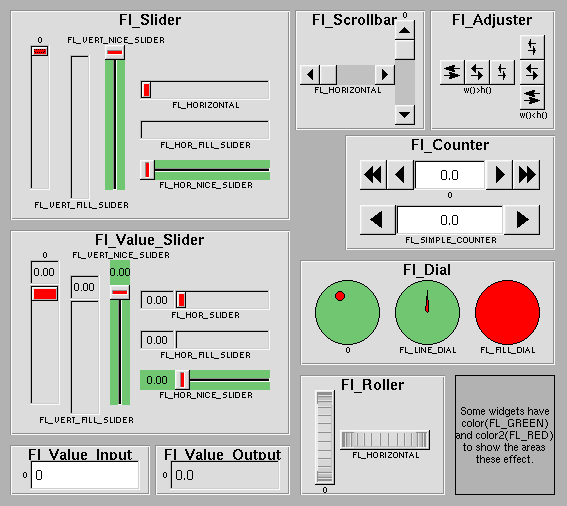
Documentation
|
|
class Fl_ValuatorClass HierarchyFl_Widget | +----Fl_Valuator | +----Fl_Adjuster, Fl_Counter, Fl_Dial, Fl_Roller, Fl_Slider, Fl_Value_Input, Fl_Value_Output, Include Files#include <FL/Fl_Valuator.H> DescriptionThe Fl_Valuator class controls a single floating-point value and provides a consistent interface to set the value, range, and step, and insures that callbacks are done the same for every object.There are probably more of these classes in FLTK than any others:
In the above diagram each box surrounds an actual subclass. These are further differentiated by setting the type() of the widget to the symbolic value labeling the widget. The ones labelled "0" are the default versions with a type(0). For consistency the symbol FL_VERTICAL is defined as zero. MethodsFl_Valuator::Fl_Valuator(int x, int y, int w, int h, const char *label = 0)Creates a new Fl_Valuator widget using the given position, size, and label string. The default boxtype is FL_NO_BOX. virtual Fl_Valuator::~Fl_Valuator()Destroys the valuator. void Fl_Valuator::bounds(double a, double b);Sets the minimum (a) and maximum (b) values for the valuator widget. int Fl_Valuator::changed() constThis value is true if the user has moved the slider. It is turned off by value(x) and just before doing a callback (the callback can turn it back on if desired). double Fl_Valuator::clamp(double)Clamps the passed value to the valuator range. void Fl_Valuator::clear_changed()Clears the changed() flag. int Fl_Valuator::format(char *buffer)Uses internal rules to format the fields numerical value into the character array pointed to by the passed parameter. The actual format used depends on the current step value. If the step value has been set to zero then a %g format is used. If the step value is non-zero, then a %.*f format is used, where the precision is calculated to show sufficient digits for the current step value. An integer step value, such as 1 or 1.0, gives a precision of 0, so the formatted value will appear as an integer. This method is used by the Fl_Value_... group of widgets to format the current value into a text string. The return value is the length of the formatted text. The formatted value is written into in buffer. buffer should have space for at least 128 bytes. You may override this function to create your own text formatting. double Fl_Valuator::increment(double,int n)Adds n times the step value to the passed value. If step was set to zero it uses fabs(maximum() - minimum()) / 100. double Fl_Valuator::maximum() const
|
Comments are owned by the poster. All other content is copyright 1998-2026 by Bill Spitzak and others. This project is hosted by The FLTK Team. Please report site problems to 'erco@seriss.com'.
